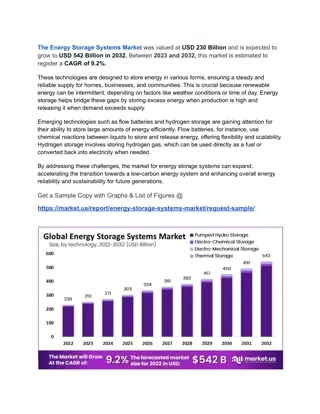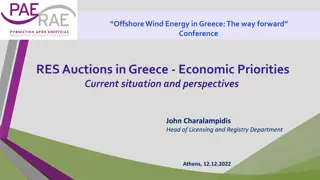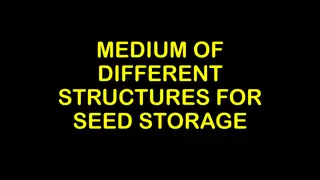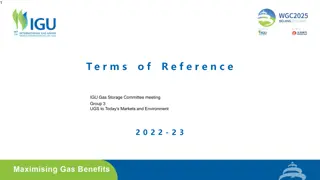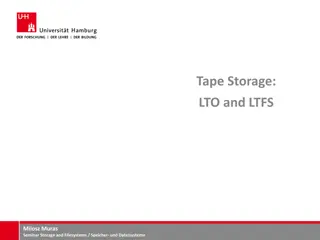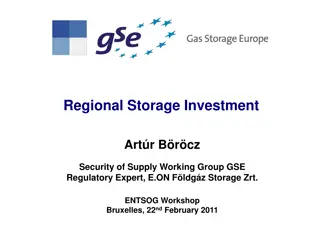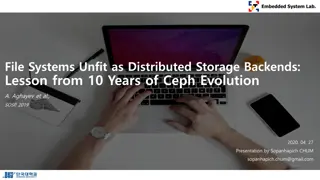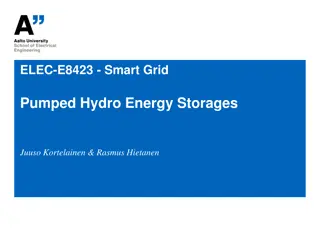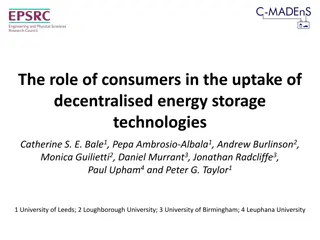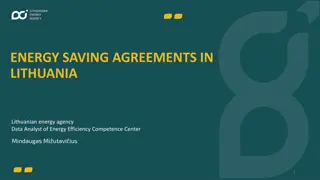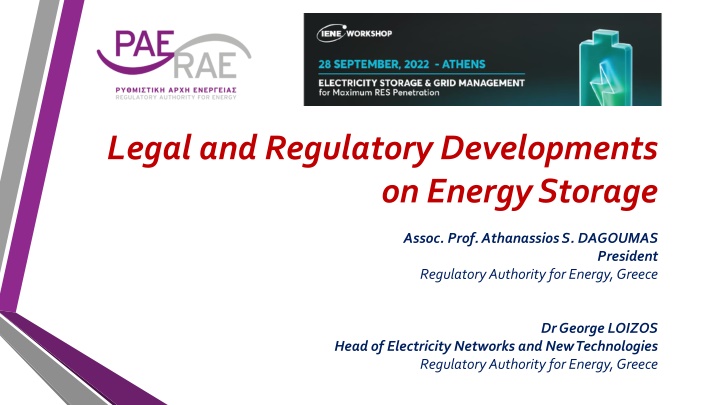
Legal and Regulatory Developments on Energy Storage in Greece
This article discusses recent legal and regulatory developments on energy storage in Greece, including the transposition of the Electricity Directive (EU) 2019/944 to Greek Law, definitions for electricity storage facilities, licensing procedures, grid connection priorities, system operation requirements, and funding initiatives.
Download Presentation

Please find below an Image/Link to download the presentation.
The content on the website is provided AS IS for your information and personal use only. It may not be sold, licensed, or shared on other websites without obtaining consent from the author. If you encounter any issues during the download, it is possible that the publisher has removed the file from their server.
You are allowed to download the files provided on this website for personal or commercial use, subject to the condition that they are used lawfully. All files are the property of their respective owners.
The content on the website is provided AS IS for your information and personal use only. It may not be sold, licensed, or shared on other websites without obtaining consent from the author.
E N D
Presentation Transcript
Legal and Regulatory Developments on Energy Storage Assoc. Prof. Athanassios S. DAGOUMAS President Regulatory Authority for Energy, Greece Dr George LOIZOS Head of Electricity Networks and New Technologies Regulatory Authority for Energy, Greece
Contents 1. Transposition of the Electricity Directive (EU) 2019/944 to the Greek Law Definitions Ownership of Electricity Storage Facilities 2. New Electricity Storage Licensing Procedure 3. Connection to the Grid Priority 4. Requirements for Grid and Demand Connection 5. System Operation Requirements 6. Funding Initiatives 2
1 Transposition of the Electricity Directive (EU) 2019/944 to the Greek Law 4951/2022 3
Definitions for Storage in the Electricity Directive Directive (EU) 2019/944 energy storage means, in the electricity system, deferring the final use of electricity to a moment later than when it was generated, or the conversion of electrical energy into a form of energy which can be stored, the storing of such energy, and the subsequent reconversion of such energy into electrical energy or use as another energy carrier; energy storage facility means, in the electricity system, a facility where energy storage occurs. fully integrated network components means network components that are integrated in the transmission or distribution system, including storage facilities, and that are used for the sole purpose of ensuring a secure and reliable operation of the transmission or distribution system, and not for balancing or congestion management; 4
Definitions for Storage in the Greek Law 4951/2022 (unofficial translation) Definitions for Electricity storage: the postponement of the final use of electricity at a time subsequent to its production, with converting it into a form of energy that can be stored, the storage of said energy and the subsequent re-conversion of said energy in electricity. Electricity storage station or storage station: All the facilities connected to the Transmission System or the Electricity Distribution Network, including pumped storage stations and hybrid stations, and perform exclusively the function of storing electricity. Definition for License of Electricity Storage Definition for Pumped Storage Hydro Stations Definition for Hybrid Stations (RES + Storage) only for the non interconnected islands and Crete Energy storage clauses have been incorporated in Greek law, with special emphasis on electricity storage 5
Ownership of Electricity Storage by the TSO (exact transfer of the provisions of the Electricity Directive in the Greek Law) 1.TSO shall not own, develop, manage or operate energy storage facilities. 2.By way of derogation, the TSO may own, develop, manage or operate energy storage facilities, i. where they are fully integrated network components after RAE s approval, or ii. where all the following conditions are fulfilled: (a) other parties, following a tendering procedure approved by RAE have not been awarded a right to own, develop, manage or operate such facilities, or could not deliver those services at a reasonable cost and in a timely manner; (b) such facilities or non-frequency ancillary services are necessary for the TSO to fulfil his obligations for the operation of the transmission system and they are not used to buy or sell electricity in the electricity markets; and (c) RAE has assessed the necessity of such a derogation, has carried out an ex ante review of the applicability of a tendering procedure, including the conditions of the tendering procedure, and has granted its approval. RAE may draw up guidelines or procurement clauses to help the TSO ensure a fair tendering procedure. 6
Ownership of Electricity Storage by the DSO (exact transfer of the provisions of the Electricity Directive in the Greek Law) 1. DSO shall not own, develop, manage or operate energy storage facilities. 2. By way of derogation the DSO may own, develop, manage or operate energy storage facilities, i. where they are fully integrated network components after RAE s approval, or ii. where all of the following conditions are fulfilled: (a) other parties, following a tendering procedure approved by RAE, have not been awarded a right to own, develop, manage or operate such facilities, or could not deliver those services at a reasonable cost and in a timely manner; (b) such facilities are necessary for the DSO to fulfil their obligations for the operation of the distribution system and the facilities are not used to buy or sell electricity in the electricity markets; and (c) RAE has assessed the necessity of such a derogation and has carried out an assessment of the tendering procedure, including the conditions of the tendering procedure, and has granted its approval. RAE may draw up guidelines or procurement clauses to help distribution system operators ensure a fair tendering procedure. 7
2 New licensing procedure 8
Types of Electricity Storage Stations and their License evaluation procedure 1. Standalone Electricity Storage Stations (BESS): Evaluation according to the criteria of Law 4951/2022 and the License Regulation for Electricity Storage (to be issued). Are awarded Electricity Storage License for 25 years. Pumped-Hydro Storage Stations (PHS): Evaluation according to the criteria of Law 4951/2022 and the License Regulation for Electricity Storage (to be issued). Are awarded Electricity Storage License for 35 years. Hybrid stations (awarded license for 25 years) 1. Electricity Storage (BESS) + RES Stations without ability to charge from the network: Evaluation according to Law 4685/2020. Are awarded RES Certificate for 25 years. 2. Electricity Storage (BESS) + RES Stations with ability to charge from the network: Evaluation according to Law 4685/2020 as a special project. Are awarded RES Special Project Certificate for 25 years. 3. Hybrid Stations (BESS + RES) for the non interconnected islands and Crete: : Evaluation according to Law 4685/2020 as a special project. Are awarded RES Special Project Certificate for 25 years. 2. 3. 9
New Licensing Criteria for the Standalone Electricity Storage Stations The licensing criteria for the standalone electricity storage stations (BESS) according to the Law 4951/2022 are: Objections notified to RAE in any way related to: a) National security, b) public health and safety, c) the protection of the environment. Energy efficiency Economic viability of the project (IRR) Technical capability of the applicant Financial capability of the applicant No health and safety issues regarding the installation itself and regarding the equipment of the network and/or the system. the operational constraints which the project undertakes to satisfy, in order to become possible to connect to congested networks, accompanied by assessment of their impact on activity and in the business plan of the project. 10
Licensing Administrative Challenges for RAE RAE strongly supports and implements the removal of regulatory barriers for participation in the electricity market: By July 2022, RAE had already licensed 337 licenses with total capacity of 23.5 GW [Standalone BESS, Mix (RES+BESS) and PSH]. Most of them were standalone battery systems issued between Jan 2021 and July 2022. Law 4951/2022 repealed all these licenses which must be updated in order to incorporate various power and capacity characteristics of the electricity storage facility. The updated License includes a variety of technical characteristics with regards to power and capacity of the storage facility. RAE considers this as an unnecessary administrative load for the update of the existing licenses. 11
Innovative Projects Licensing Challenges for RAE The Electricity Directive uses the term Energy Storage . The Greek Law uses the term Electricity Energy Storage . RAE considers innovative technologies in their licensing process Innovative hydrogen projects incorporating RES, electrolyzers, hydrogen storage tanks and fuel cells (Law must be updated to extent natural gas terms to hydrogen and alternative gases) Synchronous electricity energy storage units (synchronous condensers with or without freewheel) This technology is about storing energy in the magnetic field of a reactor as opposed to the non-synchronous electricity storage units that use inverters (batteries). Rest of energy storage technologies such as Compressed Air Energy Storage 12
3 Connection to the Grid Priority 13
Connection to the System Priority Groups/Subgroups Group A RES/HECHP A1 30km from the borders A2 Strategic Investments A3 West Macedonia All projects per investor A4 RES > 150MW RES with direct subsea cable A5 RES + Storage >300 MW, >250MWh A6 Wind Parks A7 Megalopoli A8 Epirus > 50MW A9 West Greece, >20MW A10 East Macedonia Thrace PV>50 MW Wind> 20MW Group B RES/HECHP With PPAs Group C RES/HECHP C1 Energy Communities with Local Goverments C2 Energy Communities Kozani, Florina >100MW C3 Wind Parks <=6MW C4 Private Energy Communities Kozani, Florina C5 Energy Communities East Macedonia, Thrace C6 Energy Communities West Greece Group D D1 RES + Storage withoutability to charge from the network D2 RES + Storage with ability to charge from the network Group E E1 HECHP E2 Biomass, Biogas E3 Small Hydro E4 Geothermal E5 Wind Park E6 PV on buildings E7 Self Generators E8 Offshore Wind Group F Rest of RES/HECHP Group Parallel to C P1 Biogas from waste sites P2 RES/HECHP Self generators, no surplus energy to the network P3 HECHP P4 Biomass, Biogas P5 Small Hydro P6 Geothermal P7 Solar Thermal P8 Offshore Wind P9 Mix RES+ Storage before Law 4821/2021 14
Connection to the Network Priority Groups Group A Group B Group C Group D Group E -Biomass from waste land -Pilot sea floating PV projects -Agricultural Biomass <=3 MW -Biogas>=3 MW -Innovation CRES projects -Self Gen / Net metering -Self Gen/ Virtual Net Metering -PV Energy Com. Virtual Net Metering -Small Hydro <=500 kW -Geothermal -RES projects by irrigation Organizations -HECHP distance heating, agricultural use -PV/Wind non-profit Energy Com -Self Gen. RES/HECHP, LV connected PV/Wind Energy Com for. Profit All the rest Electricity storage installations are allowed in relevant groups, where RES are allowed 15
RAE Guidelines to System and Network Operators Transparency on Grid Connection Terms Deadline 30/09/2022 (List of applications for connection terms ought to be published by Operators in their website, using the following template by 30/09/2022. If not published, hearing process will be initiated towards imposition of fines) 16
4 Technical Requirements for Grid and Demand Connection 17
Requirements for Grid and Demand Connection The technology neutrality in order to trigger competition among storage technologies among various applications and scale thus enhancing innovation and reducing costs. The revision of requirements for grid connection of generators (RfG) and on demand connection (DCC) under development. Need for new technical requirements for storage because: Storage units are connected to the grid through bidirectional converters, they shouldn t be treated as single power generating units or demand facilities Storage facility sconfiguration limitations (e.g., standalone or hybrid sites) or other specifications for synchronous or asynchronous operation when connected to the grid. 18
5 System Operation Requirements 19
Energy Availability Requirement (EAR) for FCR service ENTSOE has expressed its wish to harmonize the duration of the EAR to either 15 min or 30 min, which has resulted in a high regulatory risk for batteries. For a 15 min EAR, the needed battery sizing is of less than 1 hour whereas for a 30 min EAR it is closer to 1 hour and a half. ENTSOE proposes a 30 min EAR for batteries already built, a 1.5 h battery will be necessary to provide the FCR service. Thus, in an already installed batteries facility of 10 MW and less than one hour, the decision could lead to a 40% revenue decrease as the asset would only be able to prequalify 6 MW of FCR instead of the initial 10 MW. [The batteries designed with 15-minute discharge duration] ACER (working closely with the NRAs) is expected to issue a decision by the end of 2022. 20
6 Funding Initiatives 21
Funding Initiative for Grid Connected Electricity Storage The European Commission has approved the Greek state's funding initiative for 900 MW of energy storage. Under the state aid rules, 341 million will be allocated to grid-connected electricity energy storage systems in the form of an investment grant during project construction, followed by annual support during the first ten years of operation. The funding is valued at 380,000 /MW(378,000 USD/MW). A competitive bidding process will be organized to award the project, with awarding date by the end of 2023 and projects completion by the end of 2025. These projects will partly be funded by Greece s portion of the EU-wide Recovery and Resilience Plan, the program to mitigate the negative economic effects of the Covid pandemic. The annual support for each project will be assessed and an adjustment will be made through a clawback mechanism if the energy storage units generate excess market revenues. RAE has already issued RAE Decision 12/2021 (Recommendation) to Ministry of Environment and Energy on the CONE of each technology, including Storage technologies. 22
Funding Initiative for Pumped Hydro Storage in Amfilochia The European Commission has approved, under EU State aid rules, a Greek measure to support the construction and operation of a pumped hydroelectricity storage facility in Amfilochia, Greece. The measure will be partly funded by the Recovery and Resilience Facility ( RRF'), following the Commission's positive assessment of the Greek Recovery and Resilience Plan and its adoption by Council. The aid will take the form of a 250 million investment grant and of an annual support financed from a levy on electricity suppliers to complement market revenues, in order to reach an acceptable rate of return on the investment. The supported storage facility will have a capacity of 680 Megawatts (MW) and will be directly connected to high-voltage transmission lines. 23
RAE Decision 12/2021: Characteristics for each technology (CONE) 24
RAE Decision 12/2021: De-rating capacity factor for each technology (%) 25
Thank you for your attention !!! 132 Pireos str., 118 54, Athens el.: +30 210 3727400 E-mail: info@rae.gr


